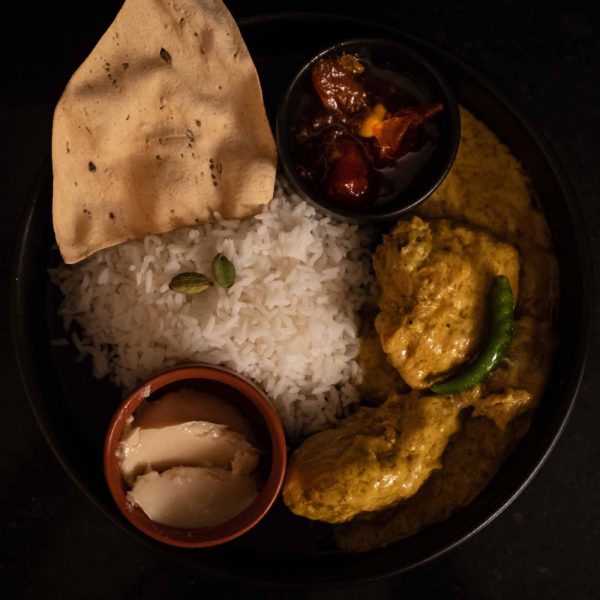
| Servings |
|
- 1 kg Chicken Curry Cut
- 1/2 cup Greek yoghurt or hung curd
- 1/4 cup Mustard Oil
- 1/2 tsp Crushed black pepper
- 1/2 tsp Kashmiri red chilli powder
- 1/2 tsp turmeric powder
- 4 tbsp black mustard seeds
- 3 tbsp yellow mustard seeds
- 1/4 cup warm water
- 2 medium green chillies
- 10 cloves smallof garlic
- 1/2 tsp salt
- 1/2 tsp turmeric powder
- 1 tsp Sugar
- 1 tsp Mustard Oil
- 1/4 cup Mustard Oil
- 2 large onions finely sliced
- 2 tsp Sugar
- Marinated chicken pieces with the marinade
- Mustard spice paste
- 200 ml coconut milk
- 1.5-2 tbsp salt
- 6 whole green chillies
Ingredients
To marinate:
For the Mustard Spice Paste
For the coconut curry:
|
   |
- Pat the chicken pieces dry. Put the yoghurt, mustard oil, crushed pepper, Kashmiri red chilli powder, and turmeric powder in a large bowl. Whisk everything together to form a thick, smooth marinade. Add the chicken pieces to the bowl and coat each piece very well with the marinade. Cover and leave this aside for 30 minutes.
- To make the Mustard Spice paste, put the black mustard seeds and the yellow mustard seeds in a small bowl. Cut two green chillies in half and add them to the bowl. Pour the warm water into the bowl and leave the mustard seeds and chillies to soak for 15 minutes.
- After 15 minutes, the mustard seeds will have soaked up all the water. Add the entire contents of the bowl to a blender jar. Do not discard any water or add any additional water. Add the garlic, turmeric powder, salt, and sugar to your blender jar. Grind the contents just until they come together as a thick paste. Do not over-grind, as this can cause the mustard seeds to emit bitterness.
- Scoop the paste into a bowl. Add 1 teaspoon mustard oil to the paste and stir it in. Keep this aside until ready for use.
- In a large heavy bottomed pot, heat up 1/4th cup mustard oil until it starts smoking. Then lower the flame and wait for a minute. Add the sliced onions to the pot. Sprinkle in the sugar and sauté the onions on low heat. This is not a brown curry, so don’t caramelise the onions. You’re looking to gently sweat them down until they become soft.
- When the onions become translucent, shake off the extra marinade from the chicken pieces and add them to the pot. Sear the meat, frying the pieces on medium-high heat for approximately 8 minutes. Stir as required to prevent sticking and over-browning. We’ll add the marinade in a bit.
- After 8 minutes is up, add the mustard paste to the mixture and once again, fry everything on medium-high heat for 2 minutes. Add the remaining chicken marinade to the pot and give it a mix. Put the lid on and cook the chicken for another 10 minutes at low-medium heat. If you’re tempted to add some water, don’t. The meat as well as the yoghurt will release enough water to stew the chicken.
- Remove the lid, and pour in the coconut milk. At this point, add the green chillies to the curry. If you like extra heat, pierce the chillies or slit them down the middle before adding. Now, gently simmer the curry for 5 minutes, without the lid.
- After the time is up, check for seasoning and add salt. I normally add about 1 ½ to 2 tablespoons of salt. Adjust the recipe to your taste. Let the curry simmer for 2 more minutes and then switch off the flame.
- Right before serving, drizzle some raw mustard oil onto the curry. This adds an additional layer of pungency. Serve your Bengali mustard chicken (Shorshe Chicken) with plain steamed rice, sweet & spicy tomato chutney, roasted poppadums, and some Bengali Sweet Set Curd (Mishit Doi). Happy eating!
This is a sweetish-mild curry, but you can increase the amount of mustard and the number of chillies for more heat—and even leave out the coconut milk for a drier, sinus-clearing-curry. When making this curry, avoid aluminium vessels as they leech into acidic foods like yoghurt. Some people like to cook their coconut curries on high heat so that the oil separates and floats on top. I prefer to cook mine on a low flame so that the coconut fats stay emulsified and the gravy remains homogenous. That way, it eats less greasy. Neither is right or wrong, it simply comes down to personal preference. Like most meat preparations, this dish tastes even better the next day, once the flavours have really had time to penetrate the chicken.